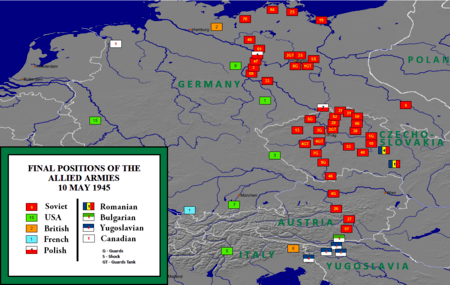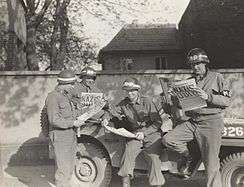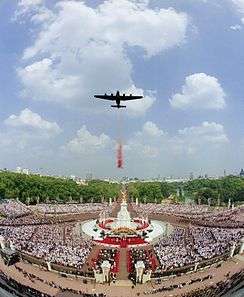Victory in Europe Day
| Victory in Europe Day | |
|---|---|
|
VE Day 70th anniversary ceremony in Paris | |
| Also called |
|
| Observed by |
France, Czech Republic, Slovakia,[1] Europe (1945) |
| Significance | End of World War II in Europe |
| Date | 7/8 May 1945[2] |
| Related to | Victory over Japan Day, Victory Day |
Victory in Europe Day, generally known as V-E Day, VE Day or simply V Day, is celebrated on May 8, 1945 to mark the formal acceptance by the Allies of World War II of Nazi Germany's unconditional surrender of its armed forces. The formal surrender of the German forces occupying the Channel Islands did not occur until the following day, May 9, 1945. It thus marked the end of World War II in Europe.
The term VE Day existed as early as September 1944,[3] in anticipation of victory. On 30 April 1945, Adolf Hitler, the Nazi leader, committed suicide during the Battle of Berlin. Germany's surrender, therefore, was authorized by his successor, Reichspräsident Karl Dönitz. The administration headed by Dönitz was known as the Flensburg Government. The preliminary act of military surrender was signed on 7 May in Reims, France[4], and the final document was signed on 8 May in Berlin, Germany.
The former Soviet Union, Serbia, Israel, and Eastern Bloc countries have historically celebrated the end of World War II on 9 May. In Ukraine since 2015, 8 May is designated as a day of Remembrance and Reconciliation, but it is not a public holiday.[5][6]
Celebrations






Upon the defeat of Germany, celebrations erupted throughout the western world. From Moscow to Los Angeles, people celebrated.
In the United Kingdom, more than one million people celebrated in the streets to mark the end of the European part of the war. In London, crowds massed in Trafalgar Square and up the Mall to Buckingham Palace, where King George VI and Queen Elizabeth, accompanied by Prime Minister Winston Churchill, appeared on the balcony of the palace before the cheering crowds. Princess Elizabeth (the future Queen Elizabeth II) and her sister Princess Margaret were allowed to wander incognito among the crowds and take part in the celebrations.[7][8]
In the United States, the victory happened on President Harry Truman's 61st birthday.[9] He dedicated the victory to the memory of his predecessor, Franklin D. Roosevelt, who had died of a cerebral hemorrhage less than a month earlier, on 12 April.[10] Flags remained at half-staff for the remainder of the 30-day mourning period.[11][12] Truman said of dedicating the victory to Roosevelt's memory and keeping the flags at half-staff that his only wish was "that Franklin D. Roosevelt had lived to witness this day".[10] Later that day, Truman said that the victory made it his most enjoyable birthday.[9]
Massive celebrations also took place in Chicago, Los Angeles, Miami and especially in New York's Times Square.[13]
Soviet Victory Day
The instrument of surrender stipulated that all hostilities had to stop at 23:01 (CET), 8th of May, just an hour before midnight. Since it was already 9th of May in the European part of the USSR, most post-Soviet states, including Russia, as well as Israel commemorate Victory Day on 9 May instead of 8 May.
Commemorative public holidays
(May 8 unless otherwise stated)
- Italy (25 April) "Festa della Liberazione" (Liberation Holiday).
- Denmark (4 May) as "Befrielsen" (The Liberation)
- Netherlands (5 May) as "Bevrijdingsdag" (Liberation Day)
- United Kingdom: In 1995 the May Day bank holiday was moved from the first Monday in May, 1 May, to Monday 8 May, for that year only, to commemorate the 50th anniversary of the ending of the Second World War.
- East Germany as Tag der Befreiung (Day of Liberation), a public holiday from 1950 to 1966 and in 1985. Between 1975 and 1990, as Tag des Sieges (Victory Day (9 May)).
- France as Victoire 1945. Orléans simultaneously celebrates both V-E Day and the anniversary of the Siege of Orléans being lifted by French forces led by Joan of Arc during the Hundred Years War on this date.
- Slovakia as Deň víťazstva nad fašizmom (Victory over Fascism Day)[14]
- Czech Republic as Den vítězství (Day of Victory) or Den osvobození (Day of Liberation)
- Poland as "Narodowy Dzień Zwycięstwa" – National Victory Day.
- Norway as "Frigjøringsdagen" (Liberation Day) "offisiell flaggdag" (official flag day) not "helligdager" (public holiday)
- Ukraine "День пам'яті та примирення" (Memorial Day)[15]
- Ukraine (9 May) "День перемоги над нацизмом у Другій світовій війні" (Victory Day over Nazism in World War II) — from 2015.[16]
- Georgia (9 May) "ფაშიზმზე გამარჯვების დღე" (Victory over Fascism Day)
- Belarus (9 May) "Дзень Перамогі" (Victory Day)
- Bosnia and Herzegovina (9 May) "Дан побједе", "Dan pobjede" (Victory Day)
- Russia (9 May) "День Победы" (Victory Day)
- Israel (9 May) Victory in Europe Day (Israel)
- Ex-Yugoslavia (9 May) "Дан победе", "Dan pobede", "Dan pobjede", "Dan zmage" (Victory Day)
- Serbia (9 May) "Дан победе", "Dan pobede" (Victory Day)
- Kazakhstan (9 May) as "Жеңіс күні" or "День победы" (Victory Day)[17]
- British Channel Islands Liberation Days: Jersey and Guernsey (9 May), Sark (10 May).
See also
References
- ↑ "Victory in Europe Day". Retrieved 2016-05-03.
- ↑ "BBC – History – VE Day". BBC Online. Retrieved 3 May 2016.
- ↑ Harper, Douglas. "VE Day". Online Etymology Dictionary. Retrieved 12 March 2016.
- ↑ Hamilton, Charles (1996). Leaders & Personalities of the Third Reich, Vol. 2. San José, CA: R. James Bender Publishing. pp. 285, 286. ISBN 978-0-912138-66-4.
- ↑ "Victory in Europe Day". Retrieved 2016-05-03.
- ↑
- ↑ The Royal British Legion
- ↑ "VE Day". www.simcoe.ca. Retrieved 2017-05-05.
- 1 2 "Truman Marks Birthday". The New York Times. May 9, 1945. p. 6.
- 1 2 "Victory Wreath From Truman Is Laid On Hyde Park Grave of War President". New York Times. Associated Press. May 9, 1945. p. 15.
- ↑ "Army Extends Mourning Period". New York Times. Associated Press. May 12, 1945. p. 13.
- ↑ United Press (May 15, 1945). "30 Days of Mourning For Roosevelt Ended". New York Times. p. 4.
- ↑ "V-E Day". Archived from the original on May 15, 2008. Retrieved August 20, 2011. University of San Diego, archived May 15, 2008 from http://history.sandiego.edu/gen/ww2Timeline/qt/v-eday.html
- ↑ Public holidays in Slovakia
- ↑ Ukraine to mark both May 8 and May 9 this year – deputy PM, Interfax-Ukraine (24.03.2015))
- ↑ Президент утвердил мероприятия по празднованию 70-й годовщины Победы и установил 8 мая Днем памяти и примирения Archived April 29, 2015, at the Wayback Machine., President of Ukraine (24.03.2015))
- ↑ Victory Day (9 May)
External links
| Wikimedia Commons has media related to VE Day. |
- WWII: VE Day, May 8, 1945 – slideshow by Life magazine (archived)
- Rare audio speeches of the famous historical persons of the USSR, etc.
- 50th Anniversary Celebration of VE Day in Moscow on YouTube by Leon Charney on The Leon Charney Report.